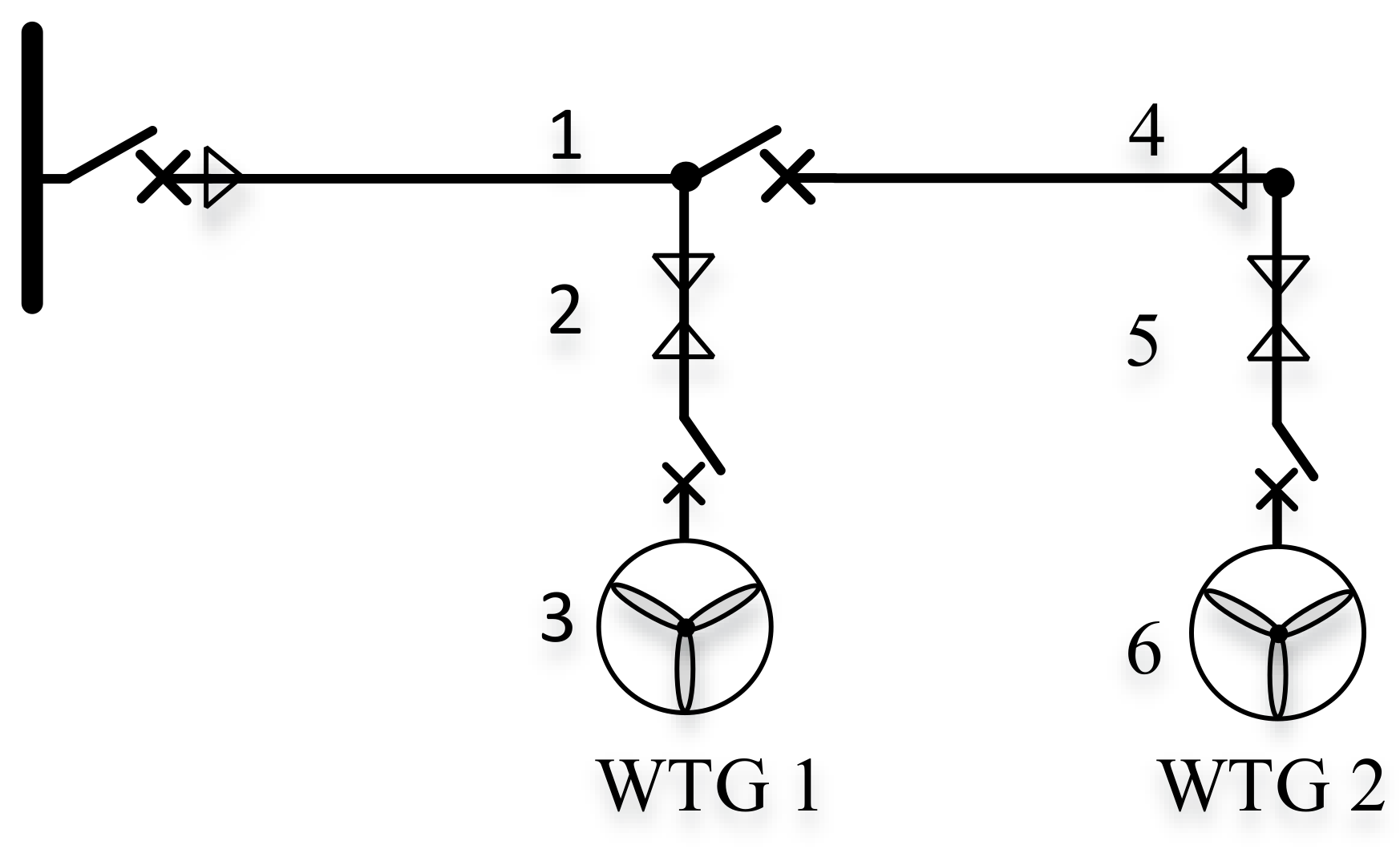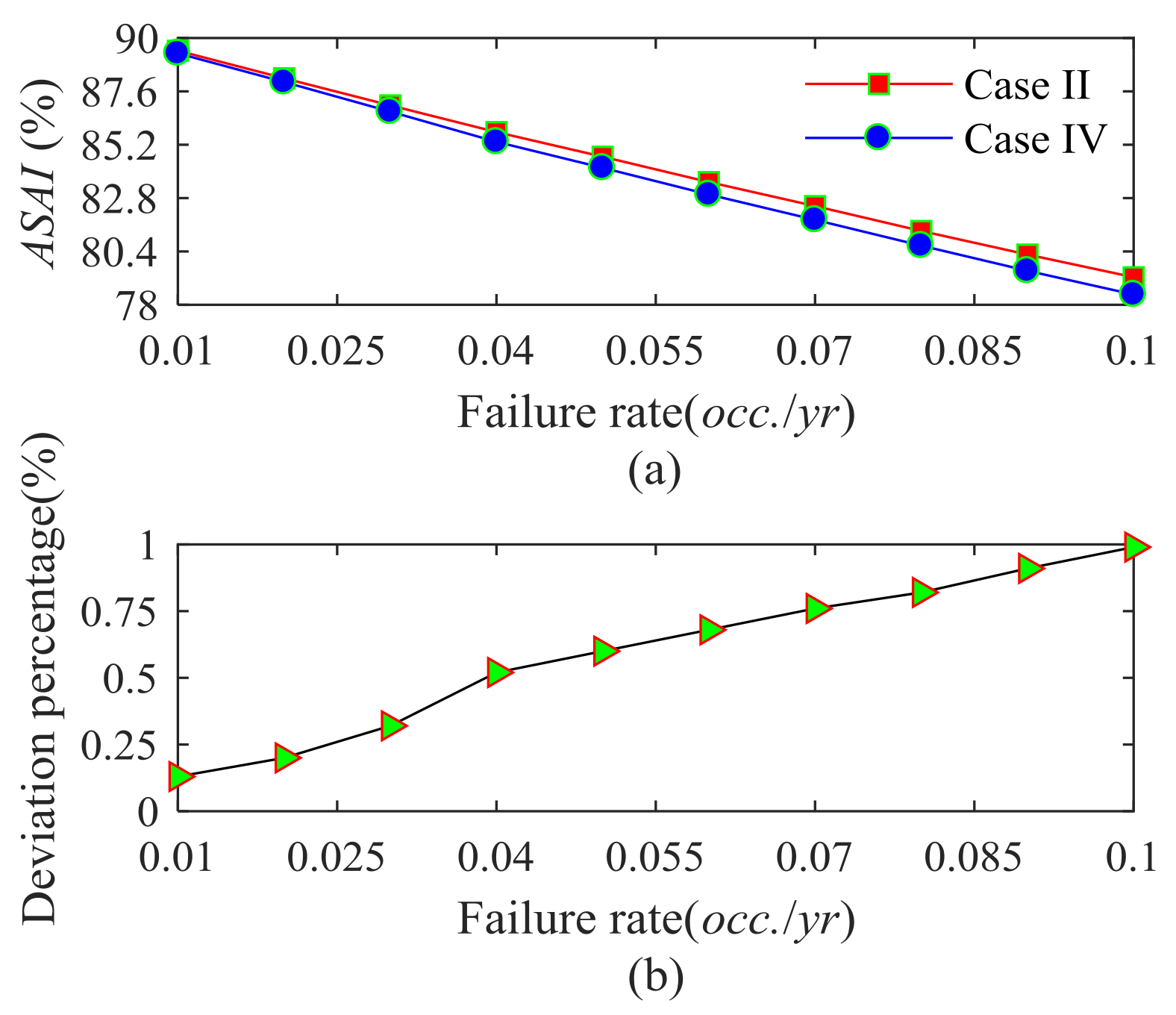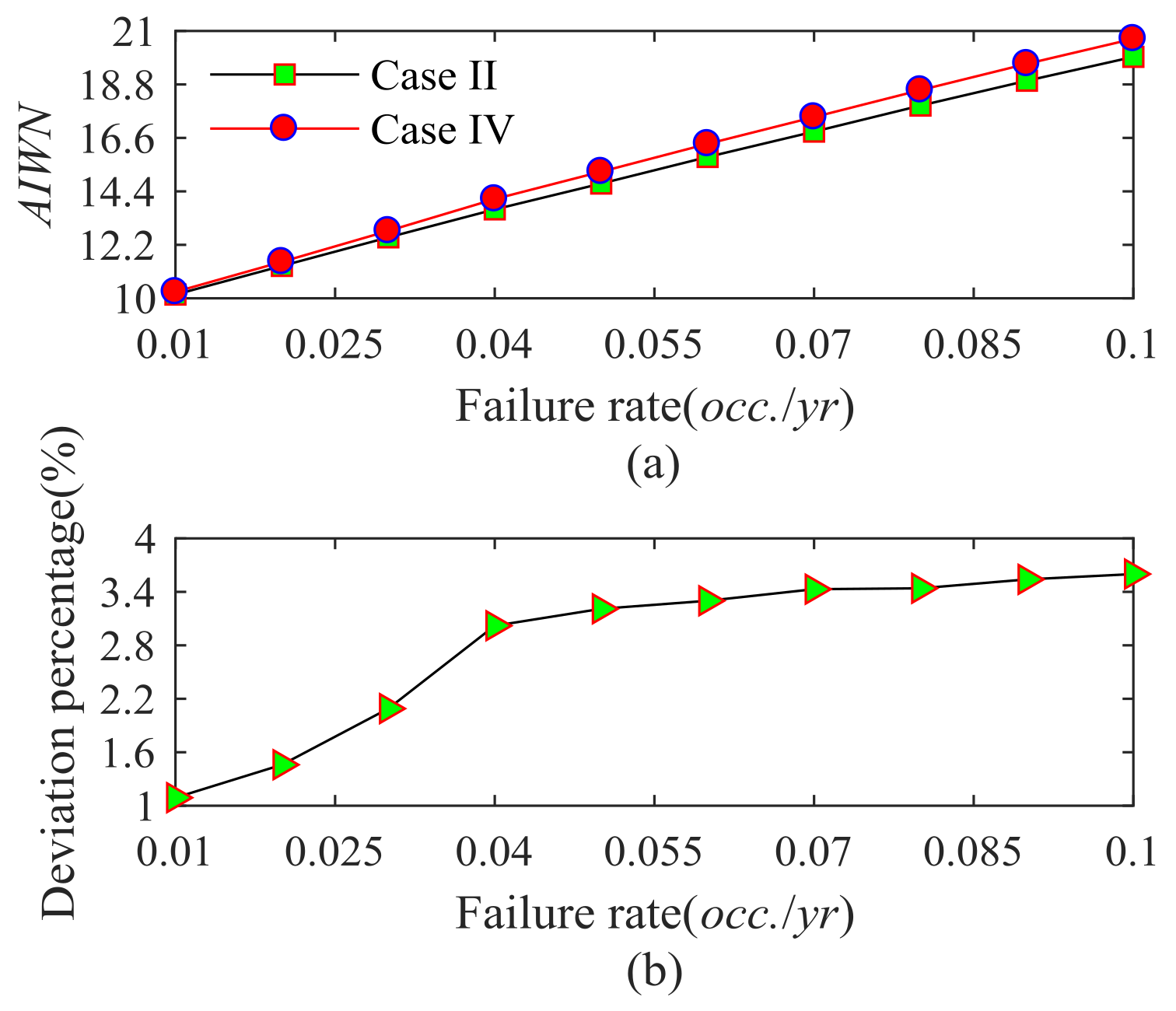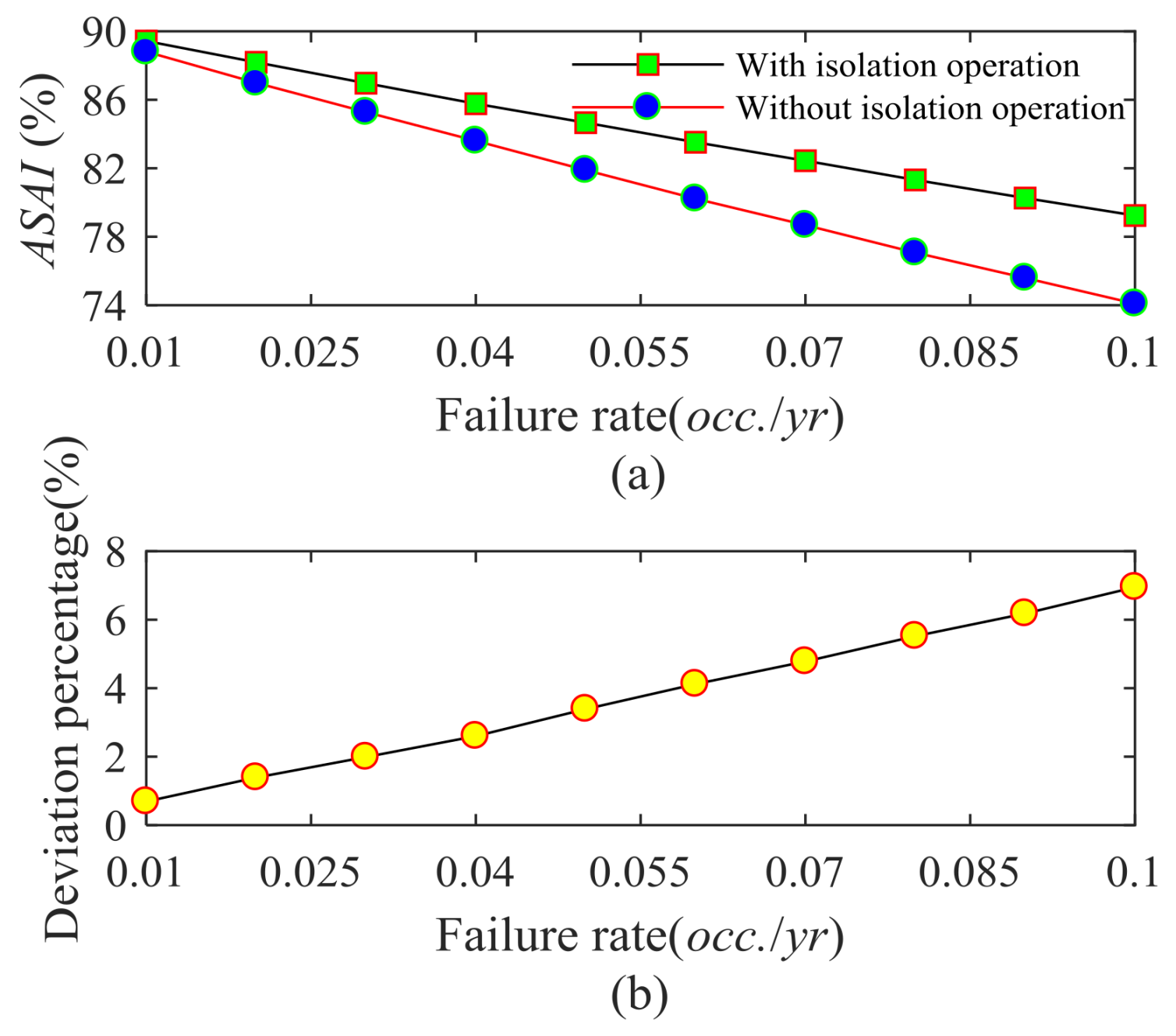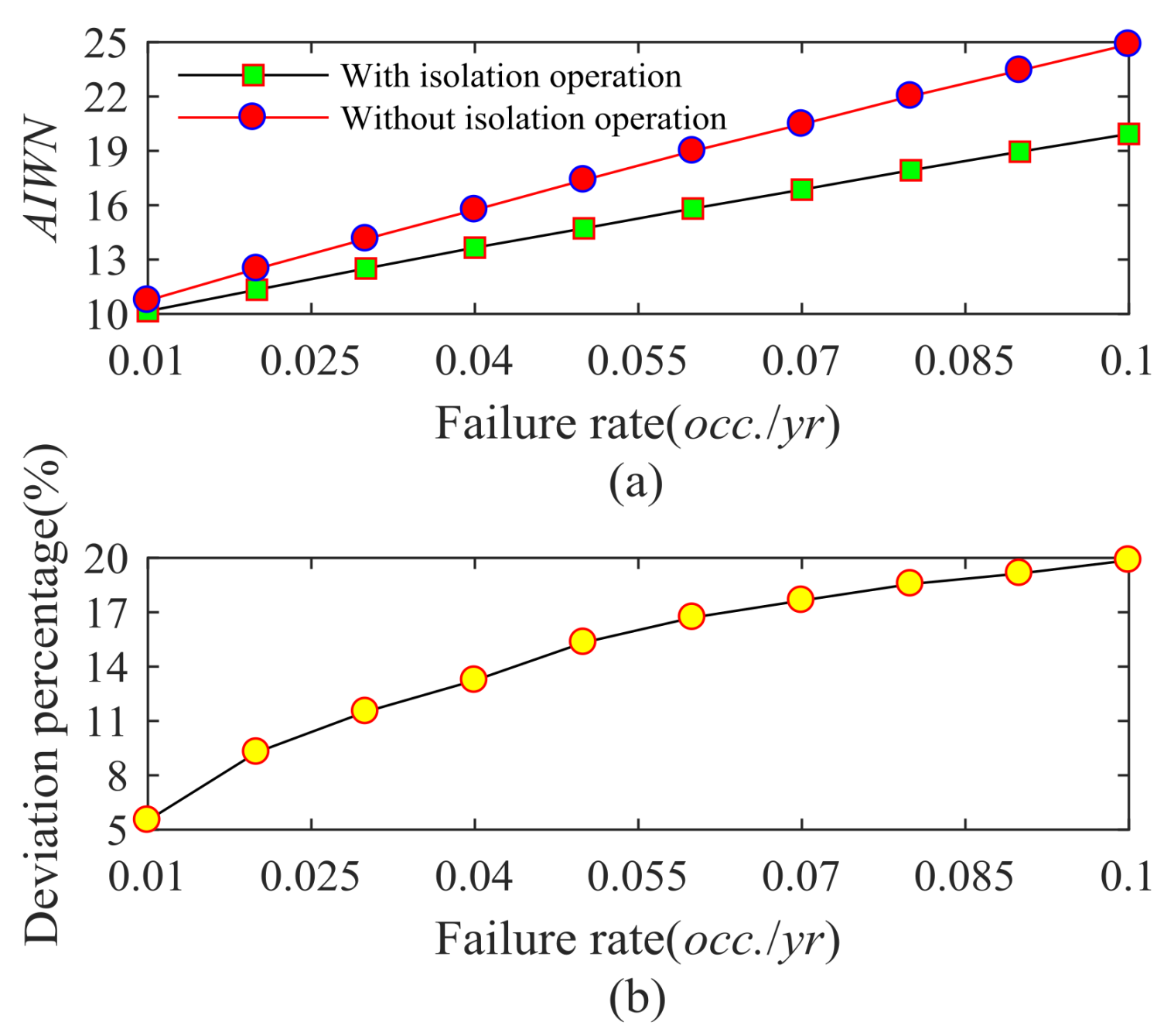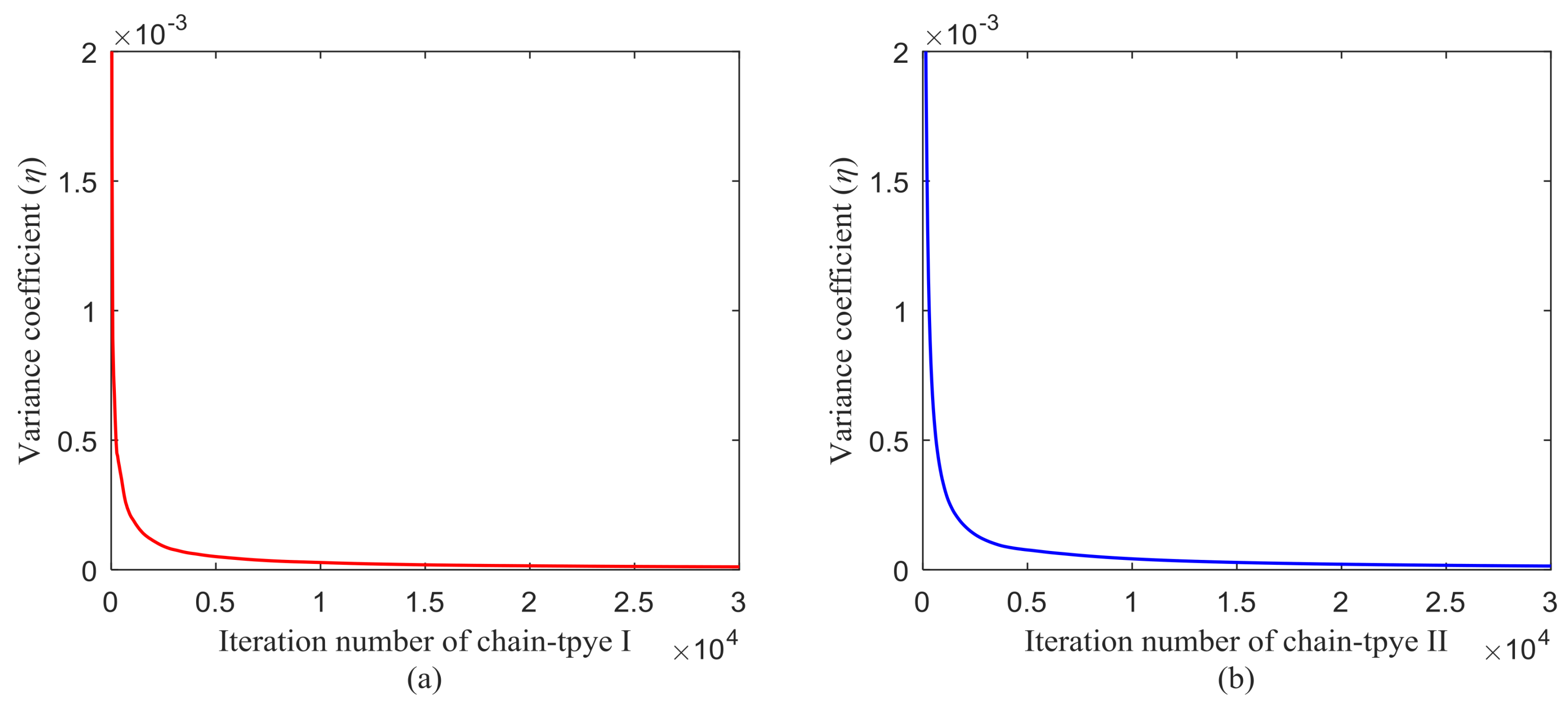1. Introduction
Wind energy, as a clean and renewable resource, has been widely exploited and utilized in the world [
1]. With the encouragement of policy and the progress of wind power technology, the scale of wind farms is also becoming increasingly large. When compared with the traditional thermal power plant or the hydropower plant, the wind turbine generator (WTG) has the characteristics of small capacity, large number, and dispersed locations in a wind farm. Because of the positional dispersity of WTGs in a wind farm [
2], the WTGs will be connected by transmission lines on the basis of a certain topology. The electrical system of a wind farm (WES) can be classified into different topology types [
3], such as chain-type topology and ring-type topology. When compared with the ring-type topology, the chain-type topology has the characteristics of low cost and simple operation mode. Hence, the chain-type topology is widely used in the realistic wind farms. On the basis of different installing positions of disconnect switches, chain-type topology can be divided into chain-type I topology and chain-type II topology. However, the different topologies have different reliability levels. Therefore, an assessment approach needs to be developed for evaluating the reliability of wind farm electrical system with the consideration of electrical topology, stochastic equipment failure, and operation mode of switches.
Due to the intermittent and uncontrolled nature of wind speed, the energy yield of wind farm is also stochastic, and it has caused an important impact on the reliability of the wind-integrated power systems. Many literatures have discussed the reliability of the power system with the integration of wind farms [
4,
5,
6]. A time-varying reliability assessment technique for short-term and medium-term reliability evaluation for power systems with a high penetration of wind power is proposed by Ding, Y. et al. [
4]. Sulaeman, S. et al. [
5] investigated an analytical technique to model the output of large wind farms for power system reliability assessment, and the variability of wind and random failures of WTGs are considered. An analytical method [
6] is proposed for developing approximate wind models when time-synchronized wind data for two wind sites are not available. The above literatures have made helpful contributions for the development of the reliability theory of wind-integrated power systems. However, some factors that have affected the wind farm reliability are not discussed, such as the stochastic failure of electrical equipment, the operation mode of switches, and the connected type of electrical topology.
The topology type of electrical system has an important impact on the operation flexibility and the wind farm reliability [
7]. Thus, the reasonable design of wind farm electrical system for power system planning and operation will be a valuable work. Some researchers have made the innovative contributions [
7,
8,
9,
10,
11,
12,
13]. Quinonez-Varela, G. et al. [
7] discussed a comparative analysis on the power loss, voltage level, and capital cost of WETs, and the advantages and disadvantages in terms of their steady-state performance and economics are analyzed. This literature has provided valuable contributions. However, the operation model of electrical switches is not considered into the reliability assessment. Lakshmanan, P. et al. [
8] analyzed a technical and economic comparison between DC and AC collection systems of offshore wind farms. However, this literature dose not discuss the impact of disconnect switches on the reliability of a wind farm. Dahmani, O. et al. [
9] demonstrated the optimization based on the genetic algorithm and the reliability based on the enumeration technique for obtaining the optimum topology of a wind farm. A section enumeration technique for assessing the reliability of wind farm electrical collector system is presented by Ref. [
10]. Although the wind farm topology and the disconnect switch are considered, the used state enumeration technique [
9,
10] cannot easily calculate the reliability indices when the wind farm scale is considerable large. The optimal layout of WTGs in a wind farm is optimized by Yang, H.J. et al. [
11], and the reliability of wind farm is also discussed. However, the electrical topology is not taken into account. Chen Y. et al. [
12] and Wei, S. et al. [
13] incorporate the electrical topology of a wind farm into the wind farm optimization, but the reliability of electrical system is not analyzed.
According to the above analysis, therefore, in order to consider the stochastic failure of electrical equipment, the operation mode of electrical switches, and the topology type of electrical system into the reliability assessment of a wind farm, this paper presents a probability transfer technique that is based on the thoughts that through transfer the unreliability of electrical system to the power transmission interruption of WTGs. The main works are demonstrated as follows. Firstly, a three-state reliability model of electrical equipment is established for replacing the exiting two-state reliability model, and a proportion allocation technique for calculating state probabilities of the three-state reliability model is presented. Secondly, the proposed probability transfer technique will be introduced. Finally, novel indices for describing the reliability of wind farm electrical system are designed, and the variance coefficient is used as a convergence criterion. The proposed technique in this paper is applied to the reliability assessment of wind farm with the chain-type I topology and chain-type II topology.
The contribution of this paper are concluded, as follows.
- (1)
A probability transfer technique is developed for incorporating the stochastic failure of electrical equipment, the operation mode of switches, and the connected type of electrical topology into the reliability of wind farm electrical system. This method is through transferring the stochastic failure of electrical system to the power transmission interruption of wind turbine generators.
- (2)
A three-state reliability model of electrical equipment is established to replace the existing two-state model for considering the impact of disconnect switch on the wind farm reliability.
- (3)
A proportion apportion technique is presented to calculate the state probabilities of electrical equipment, including the normal state, the isolation state, and the maintenance state.
- (4)
Some novel reliability indices of wind farm electrical system are designed to describe the influence of the electrical topology structure, the operation mode of electrical switches, and stochastic failure of electrical equipment.
The remainder of the paper is organized as follows.
Section 2 describes basic wind power sampling model.
Section 3 analyzes the reliability model of electrical equipment based on a proportion allocation method.
Section 4 analyzes the reliability assessment of wind farm electrical system based on the proposed method. The case studies are discussed in
Section 5. The paper is summarized in
Section 6.
2. Wind Power Sampling Model
The probability density and distribution of Weibull distribution [
14,
15] are described by
where
ws is hourly wind speed, and
α and
β are the scale and shape parameters, respectively [
16].
The simulated power output of WTG [
17,
18] can be determined by
where
Pr,
vci,
vr, and
vco are the rated power output, cut-in speed, rated speed, and cut-out wind speed, respectively.
Let R represent a random variable that has a uniform distribution in [0, 1], and F(ws) be the probability distribution of wind speed. The power output of wind farm can be simulated by:
- Step1:
Generate a random variable R, which is uniformly distributed in the interval [0, 1].
- Step2:
Model the inverse function
F−1(
R) of probability distribution
F(
ws), and simulate the hourly wind speed by
Because F(ws) has a uniform distribution in [0, 1], 1−F(ws) also has a uniform distribution in [0, 1]. Therefore, 1−F(ws) in Equation (4) can be replaced by R.
- Step3:
Calculate the power output of wind farm according to the simulated wind speed ws and the wind power curve.
- Step4:
Repeat the above steps until the simulated sample size meets the assessment requirement.
6. Conclusions
The electrical system of a wind farm has a significant influence on the reliability of a wind farm. Therefore, evaluating the reliability of different wind farm topologies can provide a reasonable decision for wind farm planning and safety operation. In the existing literatures that are related to the reliability of wind farm electrical system, the isolation operation of disconnect switches is not completely considered. The paper presents a probability transfer technique based on the thought that is to transfer the unreliability of electrical equipment to the energy transmission interruption of WTGs. First, a three-state reliability model of electrical equipment is established. Then, a proportion allocation technique for calculating state probabilities of three-state reliability model is presented. Finally, some of the novel indices for describing the wind farm reliability of considering the electrical system are designed. The number of equivalent grid-connected WTGs is applied to the convergence criterion to terminate the assessment process.
The proposed approach is used to analyze the reliability of wind farm electrical system with chain-type I and chain-type II. According to the case studies, the following conclusions can be drawn:
The reliability of chain-type I is slightly higher than that of chain-type II, and with the increasing failure rate of transmission lines, the advantage of chain-type I is increasingly obvious.
The unreliability of the wind turbine generator itself has a greater impact on the reliability of the wind farm than the unreliability of the electrical topology.
To enhance the assessment accuracy, disconnect switches should be considered in the reliability analysis of the wind farm electrical topology. The influence of disconnect switches will increase with the increasing failure rate of wind farm electrical equipment.
In summary, a reliability assessment technique of wind farm electrical topology is developed in this paper, and the proposed method can provide theoretical support for the planning and reliable operation of a wind farm.


